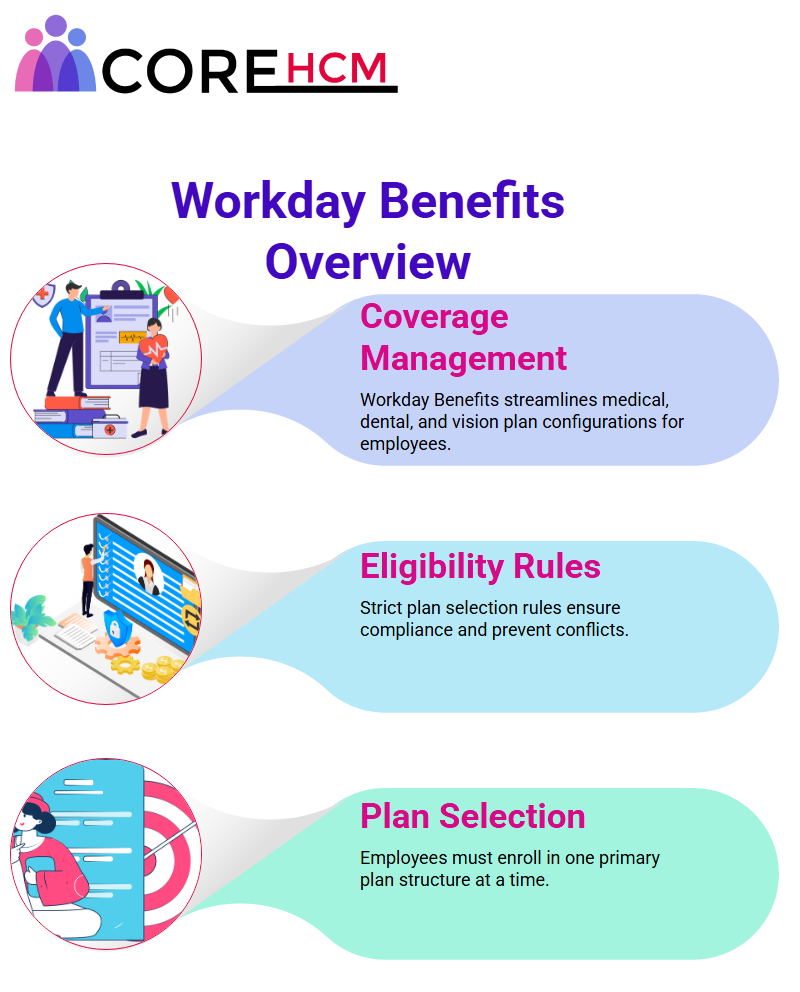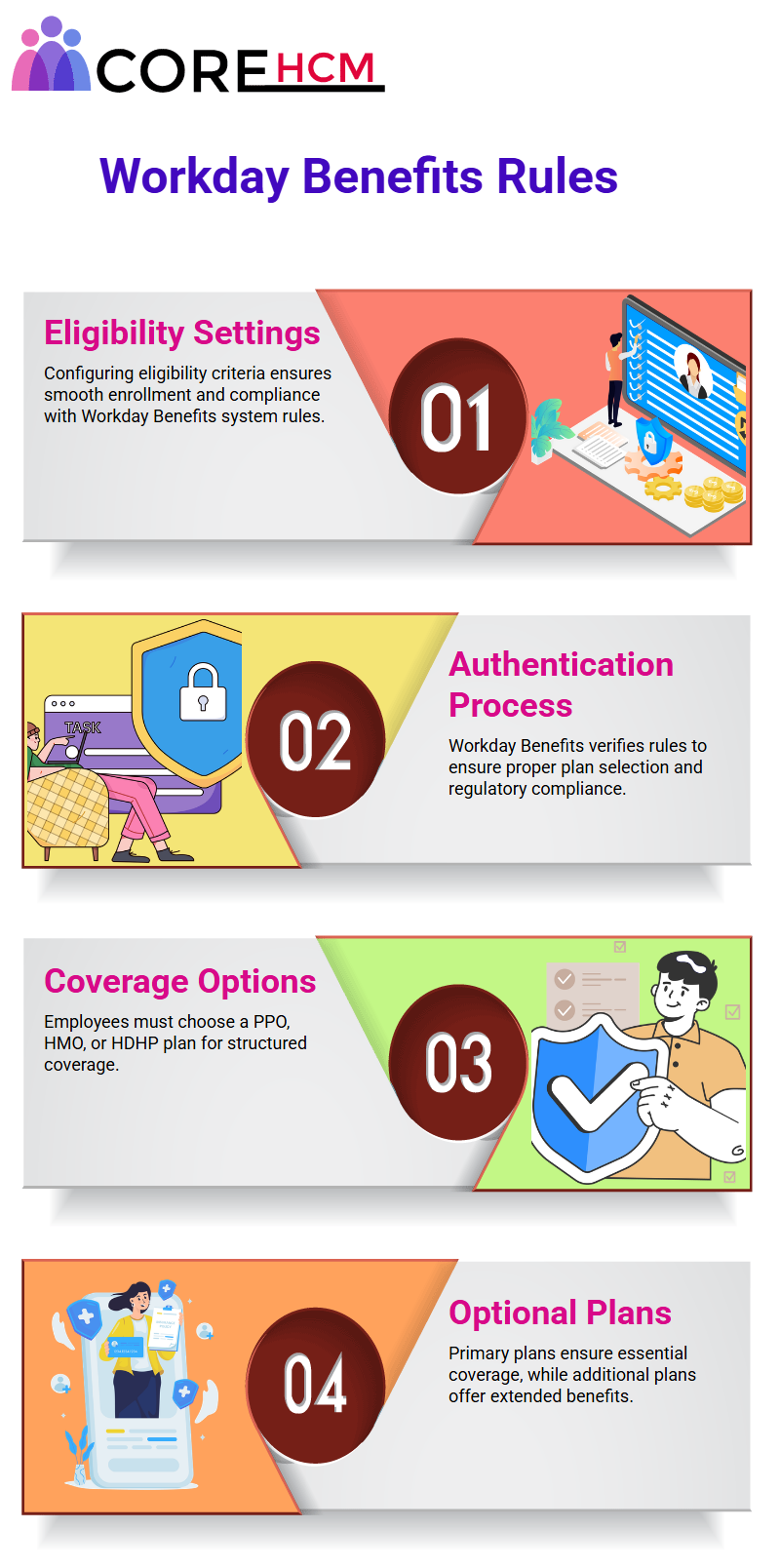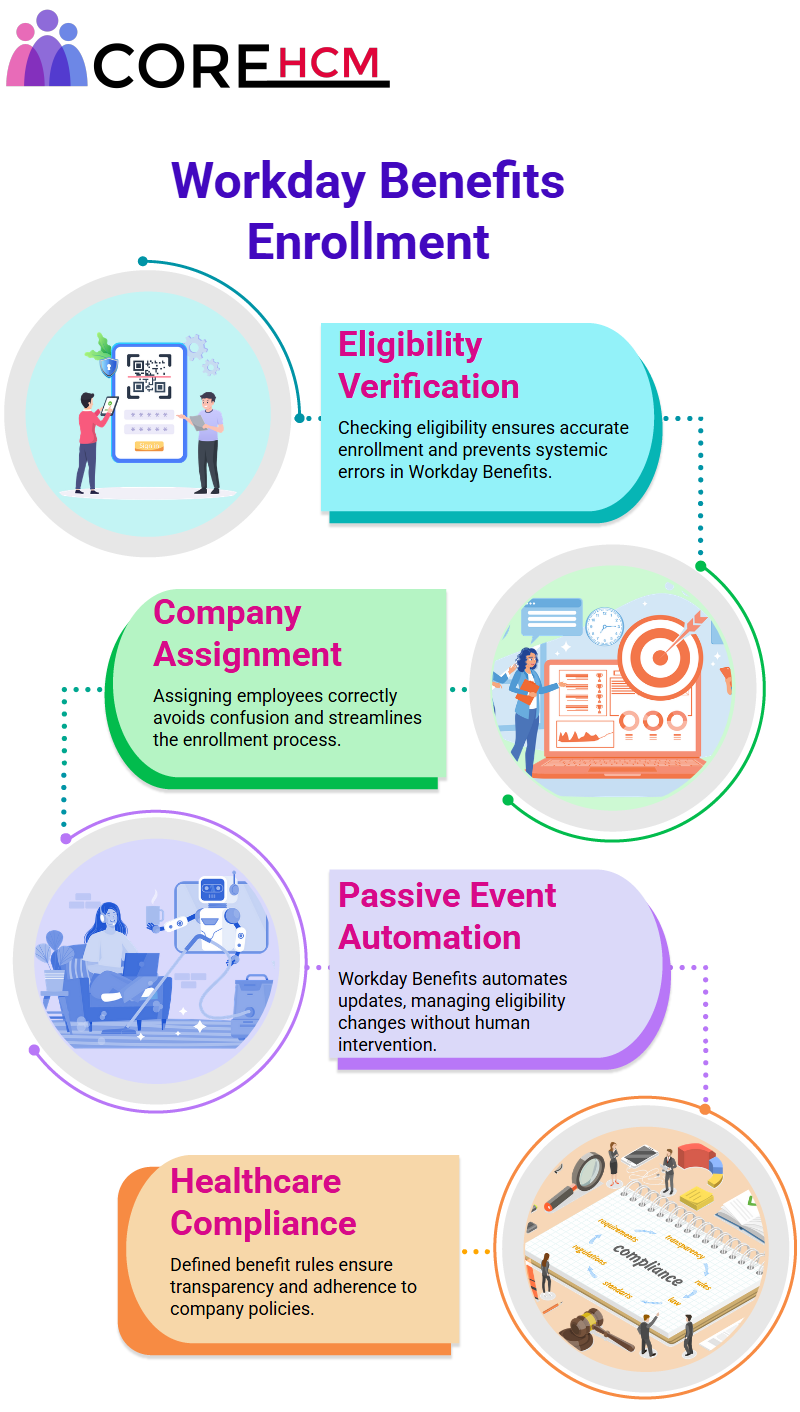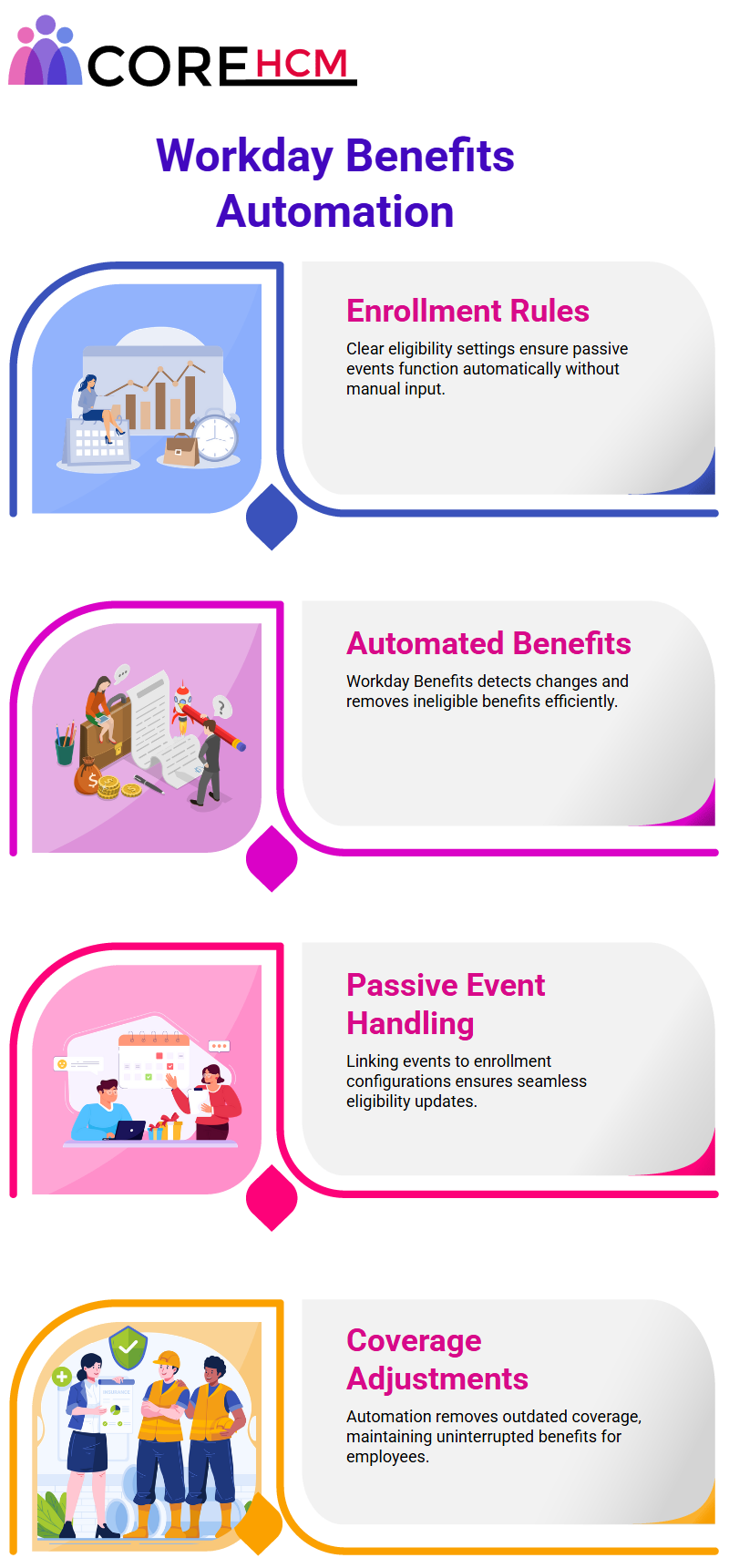Master Workday Training in Hyderabad’s Leading Experts
Workday Benefits Tutorial
Workday Benefits simplifies employee medical, dental and vision coverage management through flexible configuration options and reusable coverage types.
It enforces eligibility rules to avoid conflicts while upholding compliance.
Our system streamlines administration, increases pricing transparency, and enables informed decision-making, ultimately enhancing both employee efficiency and satisfaction.
Workday Benefits
Understanding Workday Benefits’ plan selection process is of utmost importance.
Many may question whether multiple plans can be selected simultaneously.
However, Workday Benefits outlines specific rules that must be strictly observed.
By simultaneously selecting two plans, they violated the rules.
Needless to say, once confirmed what they’d chosen without receiving an error message.
Given these circumstances, the Workday Benefits tutorial in Hyderabad expresses hope that this issue will be resolved swiftly.
Workday benefits require employees to enrol in only one primary plan structure at a time.
This policy ensures they enrol quickly without needing to negotiate their choices with their employer.
As soon as it began with selecting multiple plans, anticipated an authentication error. Issued its warning soon.
Workday Benefits has an explicit rule: to elect one medical plan simultaneously with dental and vision coverage is mandatory.
Workday Benefits makes this possible through authorised-driven enrolment.

Testing Workday Benefits Rules
At some point during my experiments, a plot emerged in which workers qualified but were unable to participate; this led to consider revising eligibility settings for perk groups.
Employers aiming for a smooth employee enrolment process are advised, according to the Workday Benefits tutorial in Hyderabad, to configure eligibility criteria within the Workday Benefits system carefully.
The system then performs authentication to verify that all provided rules comply with the requirements.
How Workday Benefits Assure Correct Plan Selection?
Selecting one plan among Workday Benefits’ various medical plan alternatives is of critical importance for employees using Workday Benefits.
Employees need to select a PPO, HMO, or HDHP plan so they can choose an ideal structure on the market.
While configuring Workday Benefits, additional plans should have been optional.
The text here contains errors, such as parsing and/or typographical errors; for a comprehensive version, please refer to the original document.
This approach ensures that primary plans cover essential benefits while additional plans provide extra coverage.

Employee Workday Benefits Enrolment Process
The Workday Benefits tutorial in Hyderabad highlights the importance of verifying eligibility and checking configuration accuracy in Workday Benefits to prevent systemic errors during employee enrolment.
One significant challenge discussed in the Workday Benefits tutorial in Hyderabad is the process of assigning employees to the correct companies within the Workday system.
Proper configuration also prevents awkward situations and ensures an effortless enrolment process.
Precision in Passive Event Coordination Through Workday Benefits
Have you ever wondered how businesses automatically update benefits eligibility?
Effective management of passive events is central to effective benefits administration.
Healthcare plans provided to workers and their dependents should follow clearly defined rules within an organisational structure, with transparency and openness.
Consider, for example, an employee’s 24th-anniversary child, who is no longer eligible to be covered under Workday Benefits, such as health insurance.
In this scenario, passive events would take over without requiring human input, allowing the process to run itself from start to finish without exertion from anyone involved in its transformation process.
A Workday Benefits tutorial in Hyderabad explains how Workday Benefits automates the configuration of passive events, ensuring compliance with legal regulations and company policies while reducing administrative workloads.
Benefits administrators can utilise these events to set authentication rules that automatically execute variations when specific conditions are met.

Setting Up Passive Events in Workday Benefits
As outlined in a Workday Benefits tutorial in Hyderabad, establishing clear and efficient eligibility rules is crucial as the first step in implementing passive events in Workday Benefits.
For instance, as soon as a child turns 24, the system should automatically detect this and cancel their healthcare plan without requiring human input or additional confirmation from users.
Gain functions are necessary when setting up passive adjustments within Workday Benefits, serving as the starting point for implementing passive modifications and making them automatically detectable by the system.
Administrative personnel should link this event to enrolment configurations so that the system can automatically detect adjustments.
Once setup is complete, passive episode implementation enables the system to identify and remove ineligible benefits automatically.
Through a Workday Benefits tutorial in Hyderabad, users learn how the platform helps manage benefits seamlessly, minimising administrative errors and ensuring reliable operations.
Modifying Workday Benefits for Uninterrupted Developments
It stands out for its automation features. Passive events were established to provide employees and dependents alike with benefits they are eligible for, without requiring constant human interaction.
When organising passive events, all the necessary eligibility conditions must be included in their design.
One such provision allows children under 24 to participate, yet forces them out once they reach 24 years old.
A Workday Benefits tutorial in Hyderabad demonstrates how Workday Benefits makes updating systems quickly and seamlessly easier, providing employees with top coverage without causing unnecessary inconveniences or distractions.
Through automatic benefit removal and renewal features, employers can focus on offering employees optimal coverage while minimising disruption.

Workday Benefits plans
This system offers an effective means of administering employee plans.
By setting specific eligibility requirements for perk events, employees receive updates on whether they meet those criteria and when.
With guidance from a Workday Benefits tutorial in Hyderabad, planning benefits events becomes a strategic way to keep employees informed at every stage of their professional journey.
When an employee turns 24, for instance, their healthcare plan automatically modifies, and notifications are sent directly to the responsible parties.
Eliminating Manual Effort in Benefits Adjustments
The Workday Benefits property utilises employee age criteria as the foundation for automating its removal process, with weekly updates to the system to ensure that value adjustments are handled smoothly and safely.
Employees can easily notify others about changes, such as dependent removal from healthcare plans, a feature thoroughly covered in a Workday Benefits tutorial in Hyderabad.
Change does not directly correlate with employees’ lack of understanding, notice of change will still be given regardless.
Assuring Agreement with Workday Benefits Policies
Workday Benefits users in an organisation should familiarise themselves with its rules to ensure an efficient process when changing benefits.
Company practices, as discussed in the Workday Benefits tutorial in Hyderabad, often involve sending notices the night before to update workers on changes for the next day.
It generates alerts and contrasts, and these notifications must also be communicated in a manner that does not conflict with corporate governance teams established to oversee all changes that conform to company regulations.

Workday Benefits and Employee Notices
Workday Benefits assumes notification responsibilities when an employee becomes eligible for perk changes, ensuring employees remain up-to-date about changes to their plans and receive timely communication about any modifications that occur.
Workers enrolled in it can easily view their history and stay informed about upcoming changes in their benefits portal.
Creating Positive Employee Experiences via Workday Benefits
Verification and data collusion, two essential steps of setting up Workday Benefits, are among the primary reasons they serve as such an integral source for managing employee plans effectively.
Poorly composed plots (containing data that violated authentication requirements) caused significant difficulty when setting them up, which highlights why properly configuring Workday Benefits can significantly alter an organisation’s entire outlook.
Currently, Workday Benefits requires certain documents from employees.
One can see this happen when hiring employees, as evidenced by the requirement to provide proof that they would only enrol in specific benefit plans.
A Workday Benefits tutorial in Hyderabad provides the knowledge to easily build organisations, job profiles, and benefit plans while making enrolment easy and administering it seamlessly.”
From assigning plans and managing open enrolment to handling payroll issues, Workday Benefits enables users to perform these functions effortlessly.
One function Workday Benefits performs is assigning the proper percentage, an issue that recurs daily.
If an employee changes their profit percentage before being paid, deviations may occur and cause errors.
However, don’t worry: Workday Benefits offers methods for tracking down and resolving these issues efficiently.
Mapping is another key part of Workday Benefits.
Returning an accurate code between outer payroll earnings and elections serves to maintain profitable plans in parallel action.
Codes from various types can lead to errors, but a Workday Benefits tutorial in Hyderabad teaches how to ensure an error-free environment through effective mapping practices.
It provides an effective tool for controlling specific rates, which is essential for running the payroll function smoothly and accurately.
Conflicting settings often cause variance in pay data relocation processes, with appropriate settings implemented through Workday Benefits, relocation can become smooth and seamless.
It has the tools necessary for effective staff plan management, so reviewing its features and team collaboration could maximise productivity from it.
Once approved for implementation, work will commence immediately on optimising Workday Benefits for staff plan oversight.

